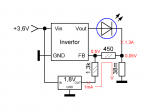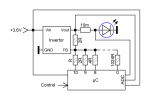This is written by author our scheme with TPS 63020. His nick is INFERION. He don’t speak English.
Hello rfhv,
I noticed your scheme, it looks a lot like mine. Your scheme has a difference in current sensor in essence. I tormented this chip long time ago. I think, the cause of ripple is in very sensitive feedback of TPS, not in slower INA138. This is general problem for all chips of this line. FB pin is intended only for active linear load such as resistor. Steep volt current characteristic increases error signal by a factor of ten that is a cause of overcorrection. This is a cause of unstable work of chip. Decreasing the ripples isn’t easy task. So, I dropped this scheme. You can solve this problem by increasing of output capacity, but I don't like the final result in this case. I can make more powerful driver in this dimensions, for example on STM32…
I see a familiar picture on your oscillograms. This is a sing at 200 KHz. It is much lower than work frequency of TPS. Feedback is singing, scheme excites itself. Low efficiency and large heatsink on previous pictures alert. My scheme “worked” too, but very heated and I saw same pictures on my oscillograph. Also, if I load my driver by resistor, then it works well.
You think that there isn’t something terrible in ripple at 200 KHz, but it is a tips for unstable work of TPS. Results of it work in this mode will be unpredictable.
Hello rfhv,
I noticed your scheme, it looks a lot like mine. Your scheme has a difference in current sensor in essence. I tormented this chip long time ago. I think, the cause of ripple is in very sensitive feedback of TPS, not in slower INA138. This is general problem for all chips of this line. FB pin is intended only for active linear load such as resistor. Steep volt current characteristic increases error signal by a factor of ten that is a cause of overcorrection. This is a cause of unstable work of chip. Decreasing the ripples isn’t easy task. So, I dropped this scheme. You can solve this problem by increasing of output capacity, but I don't like the final result in this case. I can make more powerful driver in this dimensions, for example on STM32…
I see a familiar picture on your oscillograms. This is a sing at 200 KHz. It is much lower than work frequency of TPS. Feedback is singing, scheme excites itself. Low efficiency and large heatsink on previous pictures alert. My scheme “worked” too, but very heated and I saw same pictures on my oscillograph. Also, if I load my driver by resistor, then it works well.
You think that there isn’t something terrible in ripple at 200 KHz, but it is a tips for unstable work of TPS. Results of it work in this mode will be unpredictable.
Last edited:










